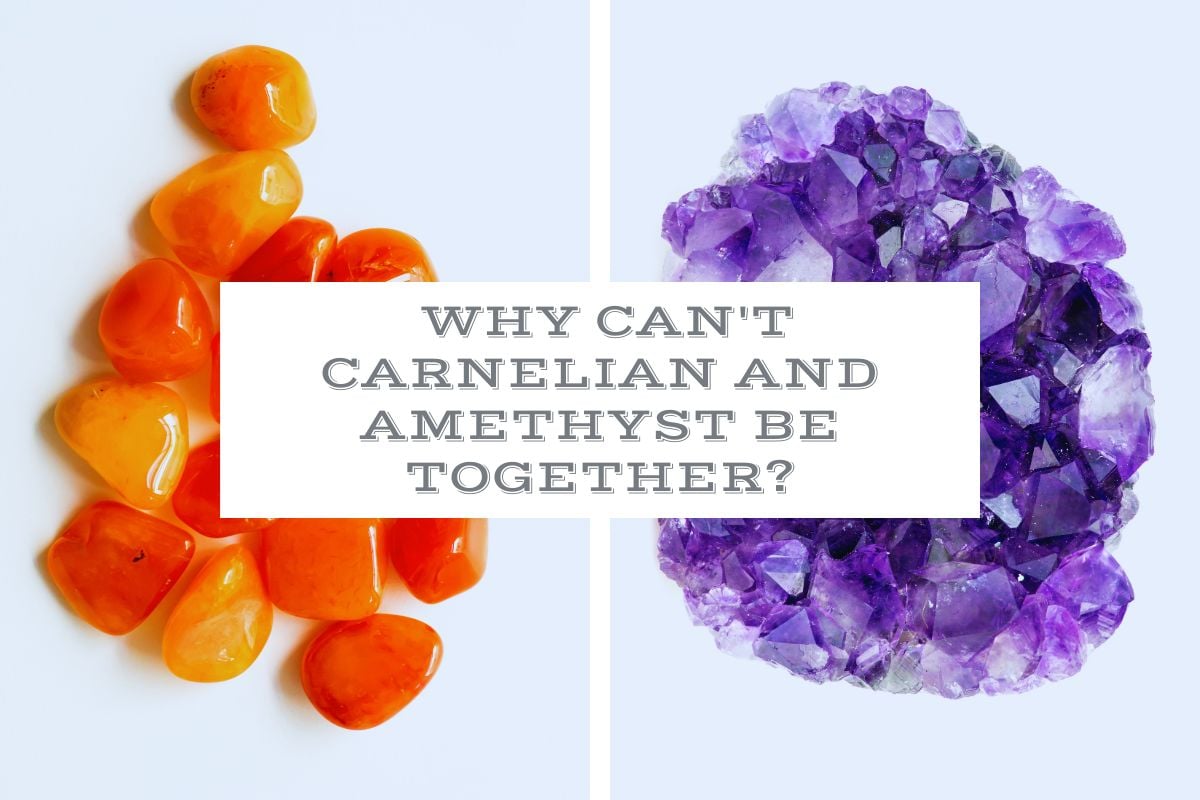Gemstones have long captivated the world with their beauty, mystery, and unique properties. Throughout history, these stones have been used for various purposes, including healing, protection, and meditation. As you delve into the fascinating realm of gemstones, it’s essential to understand that some stones, like Carnelian and Amethyst, might not work well together. In this in-depth exploration, we’ll uncover seven reasons that explain why Carnelian and Amethyst can’t be together and why it is crucial to consider the compatibility of these two gemstones.
Table of Contents
7 Reasons To Know Why Carnelian and Amethyst Can’t Be Together
Reason 1: A Tale of Contrasting Energies
In the case of Carnelian and Amethyst, their energies are strikingly different, and their respective properties can clash when combined. Carnelian, known for its warm orange-red hue, instills confidence, courage, and creativity, thanks to its energizing and motivating properties. Conversely, Amethyst is a purple stone that emits calming and balancing energy, enhancing mental clarity, spiritual growth, and emotional stability.
These opposing energies can create an imbalance when combined, making it challenging to reap the benefits of their unique properties. To maintain a harmonious energy flow, it’s essential to choose gemstones with compatible energies.
Reason 2: Overwhelming Energy: A Recipe for Overstimulation
When Carnelian’s energizing effects join forces with Amethyst’s mental clarity, they can create a potent and overwhelming energy flow. This overstimulation may make it difficult for a person to focus, relax, or find balance in their life. To prevent this, it’s crucial to strike equilibrium by selecting gemstones that complement and enhance each other’s energies, creating a balanced and harmonious energy flow.
Reason 3: Neutralizing Benefits: When Two Stones Cancel Each Other Out
Another reason why Carnelian and Amethyst can’t be together is their tendency to neutralize each other’s benefits. The conflicting properties of these two stones can cancel each other out, reducing their effectiveness. For instance, Carnelian’s invigorating properties might counteract Amethyst’s calming and soothing effects, leaving the wearer with little to no benefit from either stone. To ensure that you can fully harness the power of your chosen gemstones, it’s vital to select those with complementary properties.
Reason 4: Healing Practices: Incompatible Energies in Crystal Therapy
The incompatibility of Carnelian and Amethyst extends to crystal healing practices. In these practices, each stone has a unique purpose, and it’s essential to use them accordingly. Combining incompatible stones can disrupt the balance and harmony that these practices aim to achieve. By choosing stones that work well together, you can enhance your healing experience and promote overall well-being.
Reason 5: Chakra Balancing: An Imbalance in Energy Centers
The concept of chakras plays a significant role in the world of gemstones. Chakras are energy centers within the body that can be balanced and aligned using gemstones. Carnelian is associated with the Sacral Chakra, governing creativity, passion, and emotions, while Amethyst is linked to the Third Eye and Crown Chakras, responsible for intuition, spiritual connection, and higher consciousness.
When you combine stones with different chakra associations, you risk disrupting the balance and energy flow. To create a harmonious chakra system, it’s essential to select gemstones that complement and support each other’s chakra associations.
Reason 6: Meditation Practices: The Challenge of Setting Clear Intentions
Gemstones can be powerful tools for setting intentions and enhancing meditation practices. However, the conflicting energies of Carnelian and Amethyst can make it difficult to set a clear intention and maintain focus during meditation. Carnelian’s energizing properties may interfere with Amethyst’s calming energy, leading to confusion and restlessness during meditation sessions.
To ensure a successful meditation practice, it’s crucial to use gemstones with compatible energies that support your intentions and help maintain focus and inner peace.
Reason 7: Personal Preferences and Sensitivity: Listening to Your Intuition
It’s important to recognize that some individuals may be more sensitive to the energies of gemstones than others. For those who are particularly sensitive, combining Carnelian and Amethyst might cause discomfort or dissonance.
As you explore the world of gemstones, it’s essential to trust your intuition and personal preferences. Each person’s energetic makeup is unique, and what works for one individual may not work for another. By paying attention to how different gemstone combinations make you feel, you can better understand which stones resonate with you and support your well-being.
Bonus Reason: The Importance of Intention and Purpose
The intention and purpose behind using gemstones play a significant role in determining their compatibility. When using gemstones for a specific purpose, it’s crucial to consider whether their properties and energies align with your intentions. Combining gemstones with conflicting intentions can hinder their effectiveness and limit their potential benefits.
For example, if you’re seeking to enhance creativity and motivation, you might want to focus on using Carnelian. However, if your goal is to promote relaxation and spiritual growth, Amethyst would be a better choice. Understanding the purpose behind using gemstones will help you make informed decisions and select the stones that best support your goals and intentions.
Conclusion
In conclusion, several reasons explain why Carnelian and Amethyst can’t be together. By understanding their unique properties and compatibilities, you can make informed decisions about which stones to use for your specific needs. The seven reasons discussed in this article, along with the bonus reason, include contrasting energies, overstimulation, canceling out benefits, incompatibility in crystal healing practices, different chakra associations, conflicting intentions in meditation, personal preferences and sensitivity, and the importance of intention and purpose.
The world of gemstones is vast and fascinating, with much to learn and explore. By understanding the unique characteristics of each gemstone and how they interact, you can harness their potential and enhance your well-being, promoting balance, harmony, and personal growth. With this newfound knowledge, you can make informed decisions about which gemstones best complement each other and support your individual journey.
More articles about Crystal you may like:
The Ultimate Guide To Use Healing Crystal For Beginner
What Are The Healing Properties of Amethyst?
Carnelian Meaning and Healing Properties
16 Powerful Crystal Combinations and Pairings That Work Well Together
Which Stones Should Not Be Worn Together?
When Should I Wear Tiger’s Eye Stone?





Leave A Comment